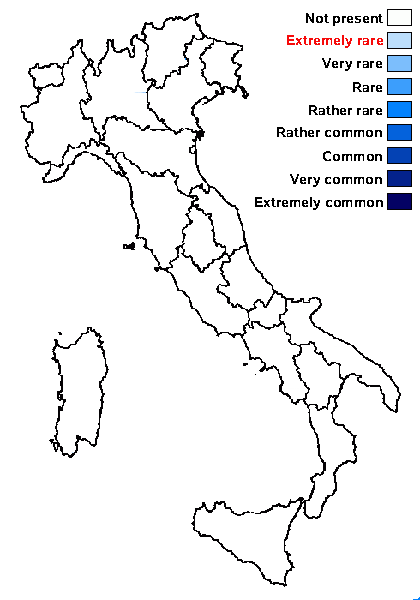Polyblastia moravica Zschacke
in Hilitzer, Preslia, 5: 3, 1927.
Synonyms:
Distribution:
Description: Thallus crustose, thinly episubstratic, white to pale reddish brown, smooth or partly rugose, sometimes poorly visible. Perithecia black, semi immersed, projecting with the up to 1 mm wide, hemispherical, flattened to depressed upper half, up to 0.5 mm wide (in section). Involucrellum thick, covering the upper half of the perithecium, tending to become thinner downwards; exciple thick, brown-black; hamathecium of periphyses and periphysoids, interascal filaments absent; hymenial gel hemiamyloid, I+ red (I+ blue at very low concentrations of I), K/I+ blue. Asci 8-spored, clavate, K/I–, fissitunicate, the wall thickened above, with an ocular chamber, dehiscent by extrusion of an endotunica to form a delicate rostrum. Ascospores submuriform, with 3 transverse septa and a 1(-2), incomplete longitudinal septa, hyaline, ellipsoid, 27-40 x 14-18 μm. Photobiont chlorococcoid. Spot tests: K-, C-, KC-, P-, UV-. Chemistry: without lichen substances.Note: on moist schists in Central Europe, with a few records from the Eastern Alps, mainly near or above treeline (Austria); to be looked for in the Italian Alps. According to Savić & al. (2008) and Savić & Tibell (2012), the species belongs to the Thelidium-clade, not to Polyblastia s.str.
Growth form: Crustose
Substrata: rocks
Photobiont: green algae other than Trentepohlia
Reproductive strategy: mainly sexual

Predictive model
Growth form: Crustose
Substrata: rocks
Photobiont: green algae other than Trentepohlia
Reproductive strategy: mainly sexual

Predictive model
 INDEX FUNGORUM
INDEX FUNGORUM
 GBIF
GBIF

